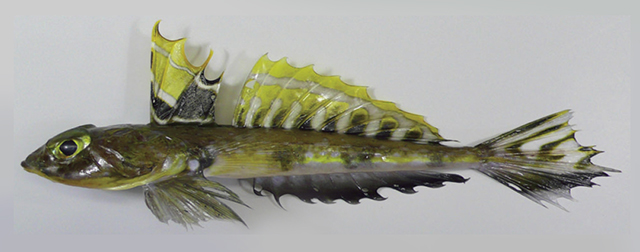| Callionymidae (Dragonets) |
| 11.13 cm SL (male/unsexed) |
|
demersal; marine; depth range - 500 m |
| NW Indian Ocean, Arabian Sea, Oman. |
|
Dorsal spines (total): 4-4; Dorsal soft rays (total): 8-8; Anal soft rays: 8-8. This species within the subgenus Bathycallionymus is distinguished from its congeners under this by the following characters: small branchial opening; short head short (3.9 in LS); large eye (2.4 in head length); preopercular spine with a long, upcurved main tip, a small antrorse barb and a larger antrorse spine, and a strong antrorse spine at its base, smooth ventral margin; first dorsal fin is slightly higher than the second (in male); second dorsal fin distally straight; pectoral fin rays 17; caudal fin slightly pointed distally, with 2 median unbranched rays with short filaments; first dorsal fin with basal black spot reaching from first to fourth membranes, the third membrane with an ocellated distal black blotch; second dorsal fin with dark grey vertical bars; distal three-fourths of anal fin is black; upper half of caudal fin with dark grey oblique bars; pelvic fin dark grey, second ray basally with a black blotch. This species differs from the similar C. profundus (characters in parentheses) in a more slender preopercular spine with the distance of the two dorsal points more than the length of the longest point (vs. stouter, distance less than the longest point); pectoral fin rays 17 (vs. 18-20); the dark pelvic fin with a black blotch basally on second ray (vs. pale, with a few dark spots); first dorsal fin with a basal black blotch reaching from first to fourth membranes, and a distal ocellate black blotch on third membrane (vs. basal black blotch only reaching from second to third membranes, and third membrane distally dark but not ocellate); distal three-fourths of anal fin dark grey (vs. only distal one-fourth of the anal fin dark); thorax of male plain white (vs. dark grey); snout dorsally with an oblique dark band (vs. without a band, but with a few dark spots); dorsal part of the pectoral fin base pale but with a dark streak behind the pectoral fin (vs. dorsal part black, no dark streak behind pectoral fin); dorsal half of the caudal fin with 4 oblique dark streaks (vs. pale, with a few dark spots). This species differs from Callionymus bentuviai in having just a single dorsal point on the preopercular spine (vs. additional to the small antrorse barb and the main tip; 2 points in C. bentuviai); pectoral fin rays 17 (vs. 19-22); median filaments of the caudal fin short (vs. very long); anal fin with the distal three-fourths dark grey (vs. distal one-fourth dark); dorsal half of the caudal fin with 4 oblique dark streaks (vs. 1 horizontal dark streak); second membrane of the first dorsal fin of the male not deeply incised (vs. deeply incised). This species is distinguished from Callionymus africanus in having just a single dorsal point on the preopercular spine (vs. additional to the small antrorse barb and the main tip; 2 points); first dorsal fin with the basal dark blotch reaching from first to fourth membranes, and a distal black ocellus on third membrane (vs. basal black blotch reaching from second to third membranes, no distal ocellus on third membrane); colouration of the second dorsal fin, with vertical dark grey bars (vs. 2 horizontal rows of dark spots and 3 rows of white spots); anal fin with the distal three-fourths dark grey (vs. distal one-fourth dark); dorsal half of the caudal fin with 4 oblique dark streaks (vs. pale, with a scattered dark spots); depressed body (Ref. 96973). |
|
|
Not Evaluated (N.E.) Ref. (130435)
|
| harmless |
Source and more info: www.fishbase.org. For personal, classroom, and other internal use only. Not for publication.

